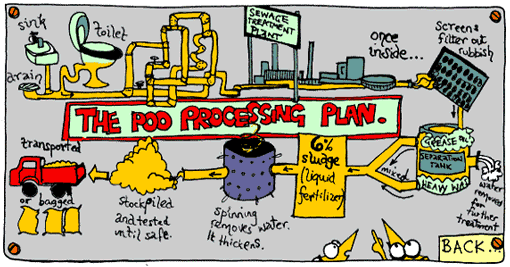



 Except we won't call it just 'sludge'. Biosolids are the byproduct of treated wastewater and sludge. The solids produced from wastewater treatment are heated in order to break down the organic matter, and to eliminate bacteria and other harmful organisms. This material becomes known as biosolids, and generally looks and feels very similar to regular soil. In Toronto alone, our city's wastewater system generates about 195 000 tons of biosolids per year.
Except we won't call it just 'sludge'. Biosolids are the byproduct of treated wastewater and sludge. The solids produced from wastewater treatment are heated in order to break down the organic matter, and to eliminate bacteria and other harmful organisms. This material becomes known as biosolids, and generally looks and feels very similar to regular soil. In Toronto alone, our city's wastewater system generates about 195 000 tons of biosolids per year. Depending on their level of treatment, biosolids can be used in a variety of different ways. For instance, they can be applied as a natural fertiliser for farms. Biosolids contain nitrogen and phosphorus, as well as a number of nutrients in trace amounts, such as magnesium, iron, and calcium, which are beneficial for crops and plants. The application of biosolids has been a regulated task for over forty years.
Depending on their level of treatment, biosolids can be used in a variety of different ways. For instance, they can be applied as a natural fertiliser for farms. Biosolids contain nitrogen and phosphorus, as well as a number of nutrients in trace amounts, such as magnesium, iron, and calcium, which are beneficial for crops and plants. The application of biosolids has been a regulated task for over forty years.
While there are all these noteworthy benefits, biosolids are not without their disadvantages. There are concerns over high concentration of metals, chemicals, and other unknown organisms within the biosolids that could prove to be harmful. It's understandable—people don't want these unknown organisms to contaminate their crops, food, environment, and so forth. But at the same time, wastewater plants go through extensive treatment processes to ensure that metal contents are moderated and harmful organisms eliminated before distribution. Some people might also have an issue with the odour that biosolids give off, especially when spread over a large field, but this smell disappears after it has been mixed into the soil anyway. In any case, making use of biosolids is a cost-effective method of recycling the nutrients and minerals that have gone down our drains. Think about it: it's a resource that is readily available and pretty much free! While biosolids come with their drawbacks, their benefits for the environment outweigh them. Disposing of biosolids would only increase the amount of waste in our dumping sites and landfills—we simply don't have enough room for that, so why not choose to perform the available alternative and recycle them for the good of our environment?
In any case, making use of biosolids is a cost-effective method of recycling the nutrients and minerals that have gone down our drains. Think about it: it's a resource that is readily available and pretty much free! While biosolids come with their drawbacks, their benefits for the environment outweigh them. Disposing of biosolids would only increase the amount of waste in our dumping sites and landfills—we simply don't have enough room for that, so why not choose to perform the available alternative and recycle them for the good of our environment?
References:
http://www.dpi.nsw.gov.au/forests/education/adventure/biosolids/making-biosolids/processing
http://www.ebmud.com/our-water/wastewater-treatment/wastewater-treatment-programs/biosolids-faq
http://www.toronto.ca/water/biosolids/index.htm
http://www.toronto.ca/water/biosolids/agriculture.htm
Blogs I commented on:
Biosolids
Human waste as Fertilizer!?
 As such, it's easy to wonder why industrialising agriculture is the more common method of growing our food. Our growing population is a factor—of course as the nation grows, so does the demand for food and produce. But considering the repercussions that come from industrial agriculture, are we really willing to risk reducing biodiversity? Do we really want to further compromise the animals'—and our own—health and welfare, just so we can save a few dollars the next time we head to the shops? I say we should look into sustaining agriculture as opposed to industrialising it. The costs of the produce that come from sustainable farms may even be lowered as we invest more and more into it in the future. It's an available alternative that is well worth getting involved in, to ensure our earth's longevity and welfare.
As such, it's easy to wonder why industrialising agriculture is the more common method of growing our food. Our growing population is a factor—of course as the nation grows, so does the demand for food and produce. But considering the repercussions that come from industrial agriculture, are we really willing to risk reducing biodiversity? Do we really want to further compromise the animals'—and our own—health and welfare, just so we can save a few dollars the next time we head to the shops? I say we should look into sustaining agriculture as opposed to industrialising it. The costs of the produce that come from sustainable farms may even be lowered as we invest more and more into it in the future. It's an available alternative that is well worth getting involved in, to ensure our earth's longevity and welfare.